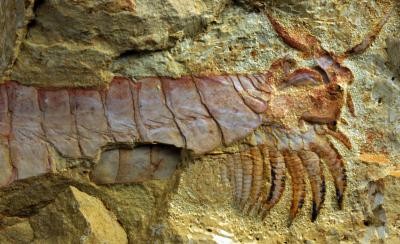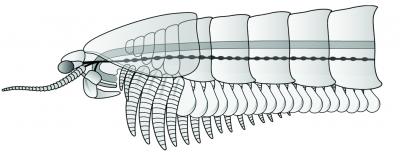 |
| The 520 million years old, early Cambrian fossil of the fuxianhuiid Chenjiangocaris kunmingensis |
Ammonites and sea urchins in a collection are one surviving piece of a far larger picture. Even so, only a small portion of preserved specimens are of good, useful quality.
Moroccan trilobites or arthropods from the Burgess Shale are truly incredible, having escaped plate boundaries or damage by scavengers.
Yet treasures have recently been discovered in 520 million year old rocks in the Kunming Region of south-west China. Earlier this year, a team of palaeontologists led by Javier Ortega-Hernandez from Cambridge's Department of Earth Sciences uncovered the perfectly preserved remains of a creature known as Chenjiangocaris kunmingensis, part of a group of creatures called the fuxianhuiids.
The fossil itself is reddish pink and contrasts beautifully with its grainy, ochre matrix. What makes it special is at the point of death, instead of settling with its underside on the seabed, it sunk to the bottom of its ocean home and was buried face up. In the case of most arthropod fossils, their face down preservation means that the delicate innards of the head are obscured by the hard carapace of the cephalon.
 |
| A reconstruction of Chenjiangocaris, showing its sensory organs, gills and carapace |
Underneath the cephalon lay two claw-like structures, antennae and more than 10 pairs of small feeding tentacles with each section perfectly preserved. By examining similar body parts in living creatures, the researchers have concluded that the apparatus was used to help the creature feed. The small tentacles were used to stir up the detritus on the sea bed and pass its organic content to the mouth.
'Since biologists rely heavily on organisation of head appendages to classify arthropod groups, such as insects and spiders, our study provides a crucial reference point for reconstructing the evolutionary history and relationships of the most diverse and abundant animals on Earth,' said Ortega-Hernandez. 'This is as early as we can currently see into arthropod limb development.' Controlling limbs requires a complex nervous system. A nervous system was also present in the fossil and represents the earliest known neural net in the fossil record.
 |
| Fossils from the Burgess Shale were the first found which documented the Cambrian Explosion |
The development of the central nervous system and sensory organs was a vital part of the Cambrian Explosion. Chenjiangocaris may represent the earliest stages of this explosion. The Burgess Shale was the place where the first fossils of the Cambrian Explosion were uncovered. In recent years, the Chenjiang Shale in China has yielded so many fossils of early animals that it has come to be known as the Burgess Shale of the East.
While, as its name suggests, Chenjiangocaris was first discovered at the Chenjiang Shale, this particular specimen actually came from the Xiaoshioba Formation. 'The Xiaoshioba biota is amazingly rich in such extraordinary fossils of early organisms,' said Ortega-Hernandez. 'Over 50 specimens of fuxianhuiids have been found in just over a year. There's massive potential for Xiaoshioba to become a huge deal for new discoveries in early animal evolution.'